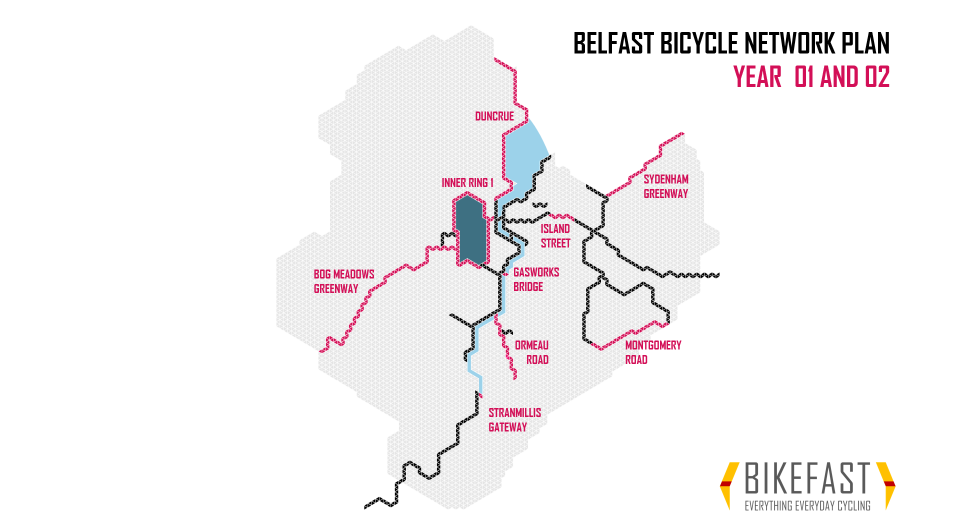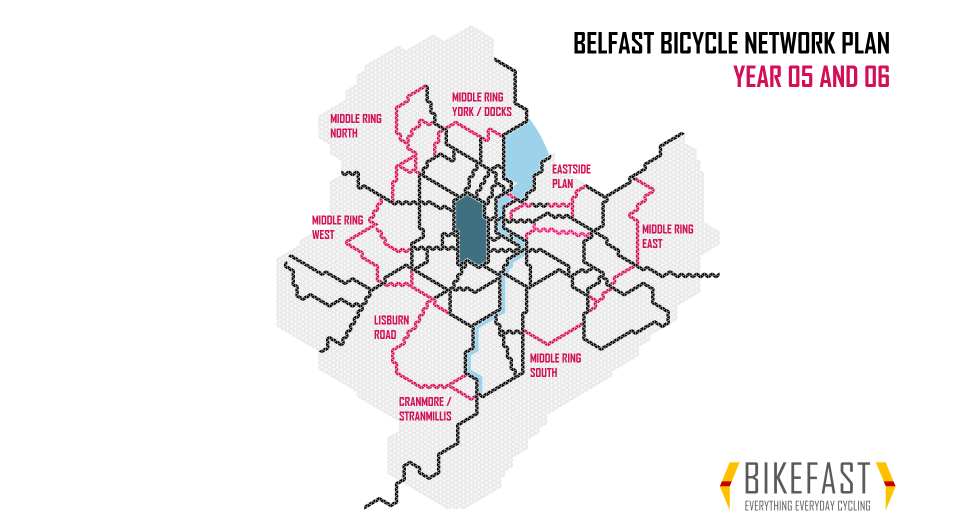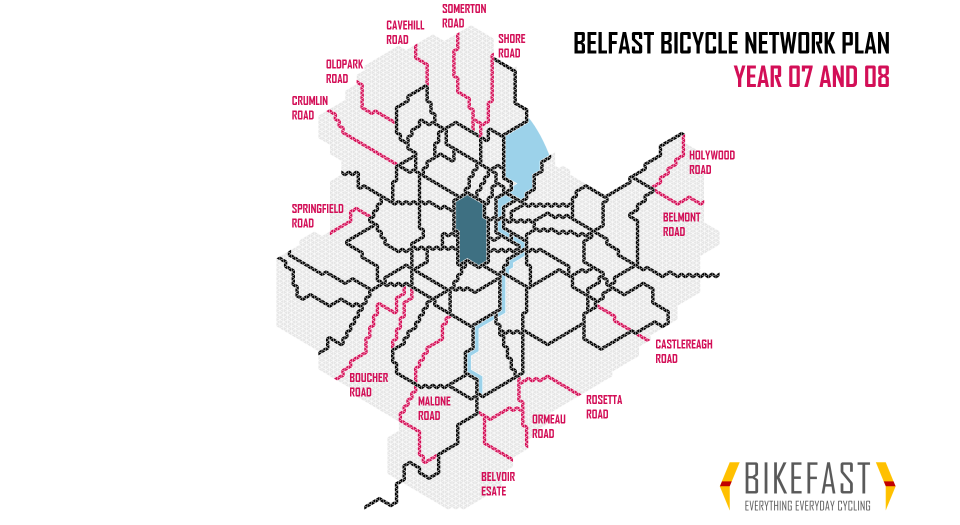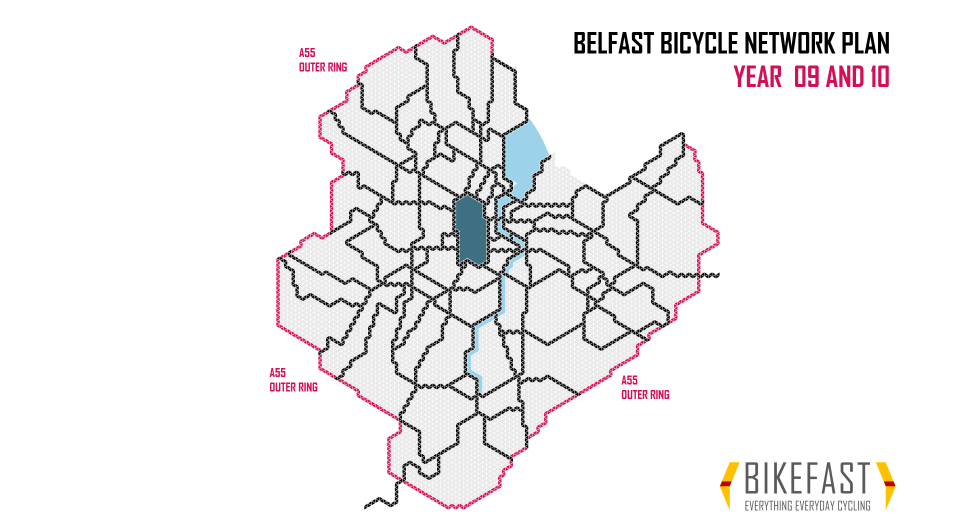It’s more than three years since the Department for Infrastructure (DfI) published its draft Belfast Bicycle Network Plan (BBNP).
The imperative to decarbonise our society is urgent and there is a growing acceptance of the need for radical change on transport emissions, even in car-addicted Belfast. Yet the plan designed to get thousands of people out of cars and onto bicycles for everyday journeys around our city remains stubbornly in draft.
Cycleway development in our city has stalled as a result and we’re at least two years behind the delivery schedule outlined in the 2015 Bicycle Strategy (which is also failing).
The policies which underpin the BBNP were agreed by previous cross-party Executives. Implementation may prove to be controversial on certain streets or sections but the overall policy, timescale, budget and identified need are not.
With the Executive back and a Minister in post, we need the final plan published now along with a delivery plan and budget. But what would that delivery plan look like? What is the best way to structure the roll-out of a city network of cycleways?
Bikefast’s counter-proposal map for the BBNP took DfI’s unambitious 128km network and suggested a network of greater density within the city’s A55 Outer Ring, totalling about 158km. Along with Sustrans we’ve also called for a condensed timescale for delivery – five years, necessary in response to the IPCC report on climate change – but for this article we’ll stick with DfI’s planned ten year project.
In stakeholder meetings in 2018 hosted by DfI’s Walking and Cycling Unit about the BBNP, Bikefast put across a simple framework for development. Start from the centre and work your way outwards. Here’s that pitch, expanded and visualised.
What’s already in place?
Total length: 31km
Despite the misleading impression left by DfI’s recently published Cycling Map, there are very few joined-up cycling routes of decent quality in Belfast. The majority of what we have is shared pedestrian pathways such as greenways, parks and towpaths.
(Click on maps to expand.)
The central spine along the river Lagan enables the Ballynafeigh ward (Ormeau Road) to have the highest cycle-to-work levels in the city – 6.2% of commuter journeys in 2011, and likely to have grown to around 10% by next year’s census.
Our existing network assessment (and plan for the future) ignores DfI Roads Eastern Division’s favourite go-to excuses for cycling infrastructure:
- advisory cycle lanes
- painted mandatory cycle lanes
- shared footways (unless a short section is unavoidable on an otherwise fully segregated route)
- bus lanes
City cycling routes must be physically separated from road space and pedestrian space. This is the only way to encourage mass uptake among all sections of society, and to ensure more vulnerable pedestrians are not put in harm’s way.
Sidestepping the city centre
Although we suggest starting from the centre, the design brief for mobility inside the central core should be separated from the rest of the city. There has been a concentration on hard cycleway infrastructure within the “inner ring” over the last six years, such as dedicated lanes on:
- Alfred Street
- Ann Street
- College Square North
- Durham Street
- Middlepath Street
- Upper Arthur Street
When more of these types of cycleway were announced for the end of the 2018-19 financial year, Bikefast strongly argued for a halt. They are inappropriate interventions which try to keep general traffic on streets where it has no business being. Recent information requests reveal that inappropriate city centre cycleways may be being used by DfI Roads Eastern as a distraction to justify downgrading cycling on the strategic approach roads. This whole approach is misguided and its time is over.
A complete streets approach, where through traffic is diverted onto more appropriate streets, can allow for pedestrian, bicycle and local access vehicles the priority they need – at volumes and speed which make the streetscape far more welcoming for active travel.
The city centre needs to be taken as a holistic project in itself, looking at options such as greater pedestrianisation, less parking supply, more restrictions on vehicle access or more drastic measures such as congestion charging. That discussion now includes recognition by the Belfast Chamber of Commerce that things must change.
Studies led by Belfast City Council and others are looking at the future of the core and its connectivity, and tying the BBNP’s delivery to those timescales risk missing the bigger opportunity.
So we propose to start the cycling network development on the central fringe.
Why inside to out?
By starting at the inner ring and working outwards, there are three main benefits:
- making the greatest impact on the most amounts of journeys
- redressing historic mistakes by leaving no part of the city behind
- catering for the rising student population around the new Ulster University campus
There are a limited number of access points out to the rest of the city, due to four main physical constraints:
- the Lagan river
- the Westlink urban highway
- the York Street Interchange (convergence of three motorway corridors)
- the central railway line
Each of these combine to create a cordon around the city core, limit access points out towards the suburbs. Options to create quietways which could parallel arterial streets are extremely limited and any ‘new’ route options would require traffic-free bridges or underpasses across road, river or rail.

The limited gateways to Belfast city centre, each needing dedicate cycling space for the city cycling network to be viable
That makes the second step critical – ensuring the arterial gateways across these barriers fully cater for cycling. The whole cycling network risks failure if residential areas remain cut off from the city centre by bicycle while cars hog the most direct route.
After these corridors are secured, it’s about finding the best routes between inner and outer rings in a radial pattern, and identifying middle rings which can be prioritised for bicycle journeys, rather than for the car.
In the early years it’s important to immediately implement at least one longer arterial route as a demonstration to locals and other parts of the city of its benefits. A time-limited experimental scheme can address inevitable negative reactions and provide a proving ground for design, usage and perhaps even retail impact.
As well as building upon and linking to existing cycling infrastructure, there is a clear need to quickly address the gap in infrastructure and cycling levels between the greenway-rich south and east of the city and the poorly-provisioned north and west.
So let’s lay out a detailed plan for how to roll out the BBNP over the next ten years.
Years 1 and 2
Length added: 16.3km
- Centre: Inner Ring 1
- East: Island St, Montgomery Rd, Sydenham Greenway
- South: Gasworks Bridge, Ormeau Rd (middle), Stranmillis Gateway Bridge
- North: Duncrue (Harbour Estate)
- West: Bog Meadows Greenway, Grosvenor Road (lower)
One of the most important aspects of the initial years of the Belfast Bicycle Network Plan will be desk-based planning for the decade of work ahead and early proving of new forms of cycleway and junction treatments – hence a slow start on actual construction.
“Inner Ring 1” provides a continuous loop around the central core, enabling short journeys by bicycle which are faster than by vehicle, and can provide the safe space needed by less confident Belfast Bikes users (and potential new subscribers).
Several greenway projects are being scoped by Belfast City Council with two of the most advanced being the Bog Meadows Greenway and the Sydenham Greenway. In a mirroring of the Glider Bus Rapid Transit project, treating these as a single project would see East-West cross-city cycling journeys opened up for residents from Andersonstown to Belfast City Airport and IKEA.
There was a reluctance to suggest cycleways on arterial streets in the draft BBNP but the public mood for climate action has shifted in the intervening years. Ormeau Road is the natural starting point for the city given the already high cycling levels, and an existing riverside pathway network to tap into.
Name that six-cars-wide road in Belfast that we can't fit #space4cycling onto, even in a ten-year Bicycle Network Plan.. #FridayQuiz pic.twitter.com/m1dNBYewYK
— NI Greenways (@nigreenways) January 27, 2017
A small project along Island Street and Ballymacarret Road, focused on through traffic removal (along with resident’s parking priority) would finally connect the city centre with the Comber and Connswater Greenways.
Another key shift in city transport priority is the upgrade of the cycle route through the Duncrue Estate. This can enable the creation of e-cargobike logistics hubs around the Port of Belfast and Giant’s Park to encourage and enable business investment in ‘last mile delivery’ services. In England there is already a £2m eCargo Bike Grant Fund, but again NI risks being left behind. Wide and continuous cycleways capable of carrying this type of traffic linking the Harbour with the city can help to decarbonise a big chunk of city logistics.
The Gasworks Bridge is one of just three infrastructure projects in the Belfast City Deal. It’s been on the agenda for 20 years, has been scoped and designed, and has planning permission. Get on with it.
Read more on the Bog Meadows Greenway, on the Gasworks Bridge, on the Montgomery Road cycleway and on the Sydenham Greenway.
Years 3 and 4
Length added: 28.4km
- East: Albertbridge Rd, East Bridge St, My Lady’s Rd / Beersbridge Rd
- North: Cavehill Rd, Corporation St, Inner Ring 2, Crumlin Rd (lower), North Queen’s St, York St
- South: Annadale, Central Greenway, Dublin Rd, Lisburn Rd (lower), Lockview, Ormeau Park, Park Rd, Ravenhill Rd, University Rd
- West: Falls Park, Grosvenor Rd, Shankill Greenway, Whiterock Rd
Years three and four see an acceleration in delivery and a much needed shift in focus to the north and west of the city.
A second inner ring is created to match in with the existing Laganside route. “Inner Ring 2” would run counterclockwise from the Yorkgate Station underpass up Duncairn Gardens to the Antrim Road, jutting back down Cliftonpark Avenue to pass Girdwood Community Hub, down Agnes Street across the Shankill and Falls and arriving at the existing pedestrian bridge over the Westlink at Roden Street.
From here a “Central Greenway” project capping off the railway line between Central Junction and Botanic Station and continuing along Cameron Street across the Ormeau Road all the way to the Gasworks Bridge would complete the loop – and provide the whole city with exceptional cycling access to the city’s two big hospitals.
Expanding out from the completed Inner Ring 1, all of the major gateways across the physical barriers between centre and suburbs will have protected, continuous cycle routes.
Out west, the Shankill Greenway project and twin routes up through Falls Park and along the Whiterock Road provide the second tranche of cycle routes to reach the A55 Outer Ring.
In the south and east of the city, with the Gaswork Bridge completed, route development starts to grow from this new node. The Ravenhill corridor becomes the critical next point of advance, enabling a shift in school commuting journeys away from the car and easy access to the city centre. With safe crossings on the Albert Bridge added to the Gasworks Bridge and the Stranmillis Gateway, and the existing route along the west bank of the Lagan, a loop can be created supporting an array of everyday journeys.
Read more on East Bridge Street, on the Ravenhill Road and on the Shankill Greenway.
Years 5 and 6
Length added: 28km
- East: Airport Rd / Dee St, Belfast Harbour, Newtownards Rd (lower), Middle Ring East, Ravenhill Pk, Short Strand
- North: Middle Ring Harbour, Middle Ring North
- South: City Hospital / Transport Hub, Cranmore through Stranmillis, Lisburn Rd (middle)
- West: Springbank, Springfield Rd (middle), Lanark Way
The middle years of BBNP delivery concentrate on the creation of a “Middle Ring” cycle route to add greater network density.
In the south and east of the city there is an informal but well trodden middle ring used by drivers to quickly circulate the city. In the north and west, where ‘Peace Walls’ haven’t closed off former routes, driving through residential streets to get from A to B is far too handy.
It’s a quirk of our city (mostly Troubles-based) that we don’t have orbital bus routes which could encourage people to ditch the car. In fact, this lack of quick cross-quarter public transport actively bakes in car dominance. So we propose prioritising cycling routes.
In the north, a link from Duncrue is established up through Alexandra Park across to the Waterworks. Routes past Solitude and along Westland Road converge on Oldpark Road, before linking between Crumlin and Shankill along Tennant Street. Closing the loop along Lanark Way, Down the Springfield Road and onto the Grosvenor Road is added to by a route through Springbank, Beechmount, past Cultúrlann, down Broadway and linking along the Donegall Road across the City Hospital site to Botanic Gardens.
In the south the Lisburn Road from City Hospital to Cranmore would link across to the Stranmillis Road and branching to Governor’s Bridge and the Stranmillis Gateway.
The eastern Middle Ring route starts with Ravenhill Park (a through-traffic removal scheme) to link Ormeau Park with the Connswater Greenway, and then cycleways along Ladas Drive, Grand Parade, North Road, Holywood Road and finishing at Sydenham Station.

Generous widths on the informal middle ring lend themselves to cycleway development
Finally, a new Harbour Bridge for pedestrians and cycling is planned to link Clarendon Dock with Queen’s Quay. This bridge would require associated cycleway improvements through Sydenham Road and the inner east. Titanic Quarter workers and residents would therefore benefit from excellent access to rail links at Yorkgate and the proposed new station at Gamble Street.
Read more on the Giant’s Park Bridge, on Ravenhill Park and on the Transport Hub Greenway.
Years 7 and 8
Length added: 25.8km
- East: Belmont Rd, Holywood Rd, Castlereagh Rd (upper)
- North: Cavehill Rd, Crumlin Rd (upper), Oldpark Rd, Shore Rd, Somerton Rd
- South: Belvoir Estate, Boucher Road, Lisburn Rd (quietway), Malone Rd, Ormeau Rd (upper), Newforge Lane, Rosetta Rd
- West: Springfield Rd (upper)
Years seven and eight concentrate on linking the Middle Ring to the A55 Outer Ring – the suburban sections.
This tackles head on the reluctance of DfI in their draft plan to place cycling routes on the city’s arterial streets. We propose cycling infrastructure on most major arterials except for the existing two Glider corridors – Falls Road and Newtownards Roads, with good parallels in the Comber Greenway and Bog Meadows Greenway – and the expected future northern Glider route along the Antrim Road, where Somerton Road can provide a good traffic-calmed alternative.
In the south another quietway can link alongside a major road, the Great Northern Street – Northbrook Street – Fane Street corridor along the railway line beside Lisburn Road. Translink have shamefully dismissed the idea of connecting this potential corridor with a greenway link into the new Transport Hub site (so much for connected thinking) but perhaps mindsets will change over the next few years?
What’s missing from the map – perhaps a dedicated cycle route along the Cregagh Road? A link between Holywood Arches and Belmont Road? The Harbour Estate on Queen’s Island? Are there other routes you think might work? Leave us a comment.
See more visualisations of the Castlereagh Road redesign.
Years 9 and 10
Length added: 28km
The last section of the BBNP to be delivered would be the whole 28km along the A55 Outer Ring. Many sections of the eastern and southern ends have a strange mix of cycling facilities delivered in the style and mindset of the early 2000s. On road painted lanes transition to shared pavements leading onto bus stops and disappearing on the approach to junctions.
For most of the A55 Outer Ring there is ample space for fully separate Dutch-style cycling routes. More difficult, but no less important for it, are the tighter hilly sections in the west and north of the city.
The Outer Ring would benefit not just those within Belfast looking to get around the city without going via the centre, but also many outside in the suburbs, Holywood, Dundonald, Castlereagh, Newtownbreda, Colin and in the Lagan valley out towards Lisburn.
See the ‘best’ section of existing cycling infrastructure on the A55 Outer Ring .
What about the ‘secondary network’?
This is the term used by DfI for its non-strategic part of the network – quietways and bicycle-prioritised streets in between the ‘main’ arterial streets.
Unfortunately the original draft Belfast Bicycle Network Plan ignored this critical part of the overall vision – the door-to-cycleway sections – leaving them to be considered after the 10 years of creating their primary network.
That siloed approach simply wouldn’t work, leaving a significant portion of any bicycle journey with some of the more dangerous environments around residential streets. The Dutch system relies upon these types of streets being significantly traffic calmed through a place-appropriate mix of:
- speed limits
- street design
- limited overtaking
- clipping through access

Barrack Street stopped up to vehicles, but allows access to pedestrians and cycling
The secondary network needs to be created alongside the primary network we’ve detailed in the maps above. Cutting the level of vehicle access, and certainly its ease, between the radial streets of the city is vital alongside a spine of arterial cycleways. Creating as many cul-de-sac street for vehicles as possible, while retaining through travel for pedestrians and cycling can encourage more modal shift, while the hard separating infrastructure of the primary network does the enabling.
Conclusion
If this version of the Belfast Bicycle Network was completed the city would have as many as 20 radial routes and 4 ring routes creating a dense web of safe and attractive cycling journey options for anyone to use. It would be the most advanced urban cycling network in these islands, instantly putting Belfast among the best cycling cities in the world.
We’ve already proposed one way to make this change happen quickly – by deliberately rebalancing the roadspace in Belfast away from vehicles to sustainable transport through a citywide road diet. And at this stage, frankly, ten years is too long given the climate crisis we face. The public agreed in the consultation on the draft plan.

Draft BBNP consultation main issues
What’s frustrating is none of this is particularly radical anymore – it’s just detailing one way to achieve an enhancement of a pre-existing government plan.
With the resumption of the Executive it’s over to our politicians, our Minister and the wit of Department for Infrastructure management to see this all happen.
Or (more likely) not.










Great work – keep it up please
Brilliant work, fair play for doing all this and keeping going in the face of rank apathy (at best) from the department.
I think the Glider is a failed scheme, so there is no problem putting cycleways along corridors it occupies currently and will occupy in the future. I study in Nottingham, where they have a tram network which is so much better than the Glider (fewer stops, smoother ride, traffic light priority, electric). The Glider should be replaced with a tram (which needs narrower lanes) and vehicle traffic should be made one way on these roads, with traffic in the other direction being on a parallel road. There would then be room for full cycling provision. All this is obviously hypothetical!